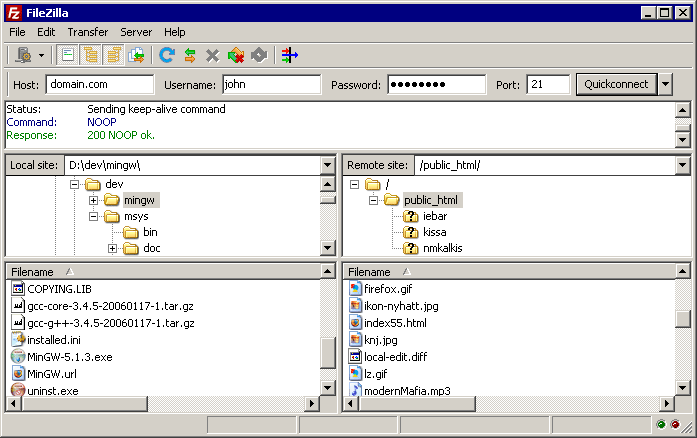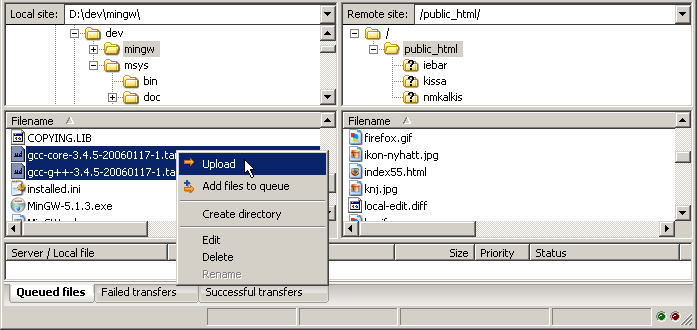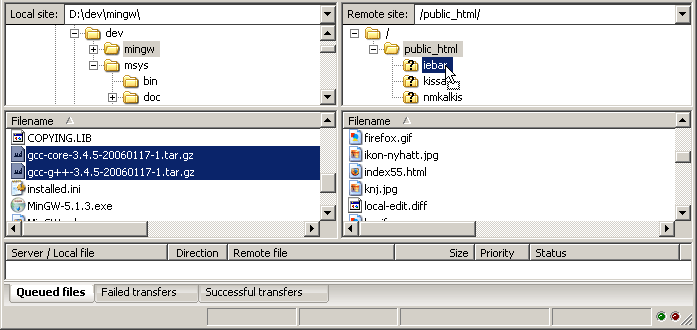Difference between revisions of "Using es"
(New page: (Spanish Translation of Using // Traslación en español de la página Using) = Guía rápida = Esta guía le da una visión general en como usar FileZilla. Por la mayoría no ti...) |
|||
| Line 23: | Line 23: | ||
== Navegar el servidor == | == Navegar el servidor == | ||
| − | + | Después de conectar, una lista del archivos aparecer en el lado '''derecho''' de la ventana. Se lista la directoria actual en el campo "Sitio remoto." Al bajar, se ve el árbol directorio y bajo de eso, un índice de los archivos en la directoria remota actual. Se puede cambiar la directoria en tres maneras. Primero, puede haga clic dos veces en una directoria en la lista. Segundo, puede haga clic en el nombre de un directoria en el árbol directorio. Tercero, puede teclear el nombre de la directoria en el campo del sitio remoto y apreta la tecla "Enter." Siempre hay una directoria que se llama "..". Esta directoria se permite subir a la directoria antecesora de la directoria actual. | |
[[Image:Navigating-remote.png]] | [[Image:Navigating-remote.png]] | ||
| − | == | + | == Navegar su maquina local == |
Navigating on your machine works almost like navigating on the server. The current local folder and the local directory tree are displayed on the '''left''' side of the main window by default. | Navigating on your machine works almost like navigating on the server. The current local folder and the local directory tree are displayed on the '''left''' side of the main window by default. | ||
| Line 34: | Line 34: | ||
| − | == | + | == Transferir archivos == |
You can upload or download a file by double-clicking on it. It will be added to the transfer queue and the transfer starts automatically. To transfer folders and/or multiple files, select them and right-click the selection. Then you can click on Upload/Download in the popup menu. | You can upload or download a file by double-clicking on it. It will be added to the transfer queue and the transfer starts automatically. To transfer folders and/or multiple files, select them and right-click the selection. Then you can click on Upload/Download in the popup menu. | ||
Revision as of 11:30, 13 December 2008
(Spanish Translation of Using // Traslación en español de la página Using)
Guía rápida
Esta guía le da una visión general en como usar FileZilla. Por la mayoría no tienes que configurar FileZilla, y por eso puede empezar trabjando con el programa directamente.
Conectar a un servidor FTP
Usar el bar de Conexión Rápida
Se puede conectar a un servidor FTP por ingresar la dirección del servidor en el campo de "Servidor".
To connect to an FTP server, enter the address of the server into the host field of the Quickconnect bar. If it is a special server type like an SFTP server, add the protocol in front of the address. In case of an SFTP server, start the address with 'sftp://'. Enter the port of the server into the port field if it is not the default port (21 for FTP, 22 for SFTP).
Si el servidor requiere usuario y contraseña, ingreselos en los campos correspondientes. Si no, el defaulto de anonymous se usará. Haga clic en Conexión rápida o tecla Enter para conectar.
Please notice that the Quick Connect is for... quick connections - so there is no way to edit the quick connections list which stores the last 10 entries. To store FTP server names you should use the Site Manager, instead.
Usar el Gestor de sitios
Se puede usar el Site Manager de FileZilla para especificar parámetros específicos y conectar al sitio FTP deseado.
Después de conectar, una lista del archivos aparecer en el lado derecho de la ventana. Se lista la directoria actual en el campo "Sitio remoto." Al bajar, se ve el árbol directorio y bajo de eso, un índice de los archivos en la directoria remota actual. Se puede cambiar la directoria en tres maneras. Primero, puede haga clic dos veces en una directoria en la lista. Segundo, puede haga clic en el nombre de un directoria en el árbol directorio. Tercero, puede teclear el nombre de la directoria en el campo del sitio remoto y apreta la tecla "Enter." Siempre hay una directoria que se llama "..". Esta directoria se permite subir a la directoria antecesora de la directoria actual.
Navigating on your machine works almost like navigating on the server. The current local folder and the local directory tree are displayed on the left side of the main window by default.
Transferir archivos
You can upload or download a file by double-clicking on it. It will be added to the transfer queue and the transfer starts automatically. To transfer folders and/or multiple files, select them and right-click the selection. Then you can click on Upload/Download in the popup menu.
You can also drag the files from one side and drop them on the other side. To add files to the queue so that they will be transferred later, select them and click Add to Queue from the popup menu. You may also drag the files directly into the queue. Click on the ![]() button on the toolbar to start the transfer.
button on the toolbar to start the transfer.
Or, you can click on a file, then drag the file (a box is added to the arrow cursor) to the folder where you want to move it. The folder will be highlighted when you are over it. Let go of the mouse button and the file will be moved to the folder.
Detailed Information Pages
Detailed information on other aspects of the FileZilla client can be found on the following pages:
File Transfer Notes
FileZilla uses multiple FTP sessions. One session gets used purely to browse the server. The other sessions get used to do the file transfers. That way, you can always browse the server even during transfers.
For example, here is a simple car analogy: You order a pizza using your telephone (aka the browsing connection), then you hang up the telephone. Then the delivery man drives the pizza in his car to your location (the transfer connection). While the pizza is transferring, you can phone somebody else, like for example your garage because your own car is broken ;)
Reducing simultaneous connections for incorrectly configured servers
If you get a 421 Too many connections from this IP (<number>) error, the FTP server is restricting your number of connections. There are even servers restricting it to one connection at a time.
The preferred solution would be to contact the server administrator and encourage him/her to configure the server correctly (FTP uses more than one connection by design!). But if you need access immediately, there is a workaround:
1. Open the Site Manager (File - Site Manager... or the first toolbar button)
2. Create an entry for that server, enter all details you know, the more precise, the better
3. Open the 'Transfer Settings' tab
4. Tick the 'Limit number of simultaneous connections' checkbox
5. Enter the desired limit into the 'Maximum number of connections' field
Now, if you connect using the Site Manager entry, connections will be limited.
Note: If you limit connections to 1 only, there is a major drawback: You cannot browse the server anymore while a transfer is in progress!
Troubleshooting
Re-registering the shell extension
Especially on Vista it can happen that Drag&Drop fails and you get an error message stating the shell extension doesn't work. In this case you need to re-register it. Here's how:
1. Open a command prompt as administrator. This is important!
Start Menu - All Programs - Accessories: Right Click 'Command Prompt', select 'Run as administrator'
2. Navigate to the Filezilla program directory. Example:
cd "\Program Files\Filezilla FTP Client"
3. Re-register the shell extension.
Type 'regsvr32 fzshellext.dll' (without quotes of course)
4. If you have 64bit OS, you need to perform an additional step.
Type 'regsvr32 fzshellext_64.dll' (no quotes as well)
If you get the reply 'DllRegisterServer in ... succeeded.', you've done it.




